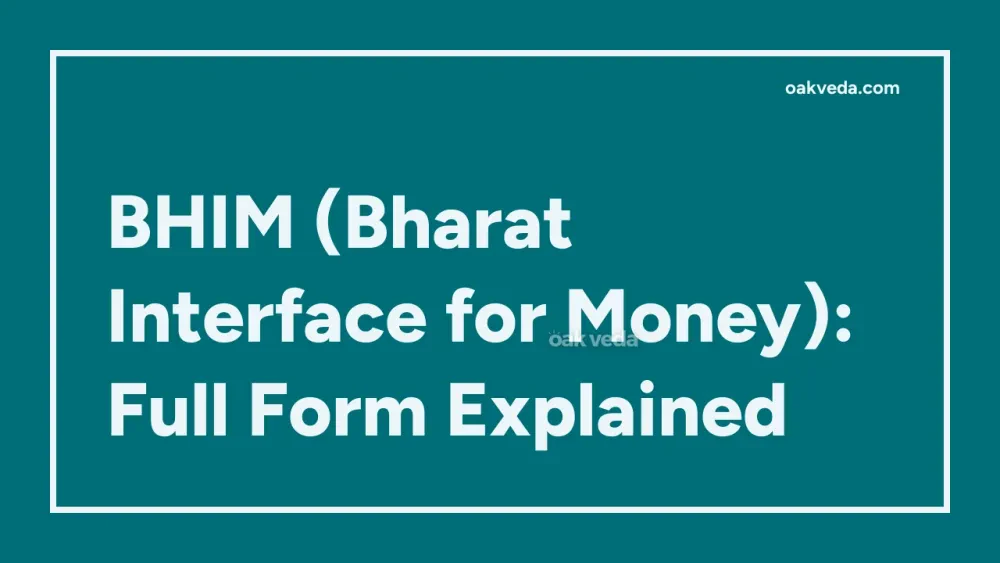
What is the Full Form of BHIM?
BHIM is an acronym that stands for Bharat Interface for Money. This mobile payment application has revolutionized digital transactions in India, making it easier for millions of users to send and receive money instantly.
What is Bharat Interface for Money?
Bharat Interface for Money, commonly known as BHIM, is a mobile payment platform developed by the National Payments Corporation of India (NPCI). Launched in 2016, BHIM was created to promote digital transactions and financial inclusion across India. The app leverages the Unified Payments Interface (UPI) to facilitate quick and secure money transfers between bank accounts.
Origin and Development of BHIM
The development of BHIM was initiated as part of the Indian government's push towards a cashless economy. Following the demonetization move in November 2016, there was an urgent need for a robust, user-friendly digital payment solution. BHIM was conceptualized and developed in record time to meet this demand.
Named after Dr. Bhimrao Ambedkar, a key architect of the Indian Constitution, BHIM symbolizes financial empowerment for all sections of society. Since its launch, the app has undergone several updates and improvements to enhance its functionality and user experience.
How does BHIM work?
BHIM operates on the UPI platform, which allows users to transfer money directly between bank accounts using a smartphone. Here's a simplified overview of how BHIM works:
- User Registration: Users download the BHIM app and register with their mobile number linked to their bank account.
- Bank Account Linking: The app automatically detects and links the user's bank account(s).
- UPI PIN Creation: Users set up a UPI PIN for transaction authorization.
- Transaction Initiation: Users can send money using the recipient's mobile number, UPI ID, or by scanning a QR code.
- Authorization: Transactions are authorized using the UPI PIN.
- Instant Transfer: Money is transferred instantly from the sender's account to the recipient's account.
Functions of BHIM
BHIM offers a range of functions to facilitate seamless digital transactions:
- Send Money: Users can transfer funds to any UPI ID, mobile number, or bank account.
- Request Money: The app allows users to request payments from others.
- Scan and Pay: Users can make payments by scanning QR codes.
- Bank Account Management: Multiple bank accounts can be linked and managed within the app.
- Transaction History: Users can view their transaction history and download statements.
- Bill Payments: The app supports various utility bill payments.
Applications of BHIM
BHIM has found widespread applications across various sectors:
- Retail Payments: Small businesses and street vendors can accept digital payments easily.
- Peer-to-Peer Transfers: Friends and family can send money to each other instantly.
- Bill Payments: Users can pay utility bills, recharge mobile phones, and more.
- Online Shopping: Many e-commerce platforms accept payments through BHIM.
- Government Services: Some government services allow fee payments via BHIM.
Features of BHIM
BHIM boasts several features that make it a popular choice among users:
- Multi-language Support: The app is available in 20 regional languages, making it accessible to a diverse user base.
- QR Code Generation: Users can generate their own QR codes for receiving payments.
- Bank Account Switching: Easy switching between linked bank accounts for transactions.
- Transaction Limits: BHIM adheres to RBI-mandated transaction limits for security.
- Offline Payments: Supports payments to Aadhaar numbers, even in areas with poor internet connectivity.
Benefits of BHIM
The BHIM app offers numerous benefits to its users:
- Simplicity: User-friendly interface suitable for tech-savvy and novice users alike.
- Instant Transfers: Real-time money transfers between bank accounts.
- Cost-effective: No transaction fees for users (as of 2023).
- Secure: Utilizes UPI's robust security features for safe transactions.
- Interoperability: Works across all banks and financial institutions that support UPI.
- Promotes Financial Inclusion: Enables digital transactions for users without credit/debit cards.
Limitations or Challenges of BHIM
Despite its advantages, BHIM faces some challenges:
- Internet Dependency: Requires internet connectivity for most functions.
- Limited International Use: Primarily designed for domestic transactions within India.
- Competition: Faces stiff competition from other UPI-based apps and digital wallets.
- Technical Issues: Occasional server downtimes or transaction failures during peak usage.
Future Developments in BHIM Technology
The future of BHIM looks promising, with several potential developments on the horizon:
- Integration with Emerging Technologies: Possible incorporation of blockchain or AI for enhanced security and user experience.
- Cross-border Transactions: Expansion to support international remittances.
- Enhanced Biometric Authentication: Integration of advanced biometric features for improved security.
- IoT Integration: Potential compatibility with IoT devices for seamless payments.
- Advanced Analytics: Incorporation of personal finance management tools and insights.
FAQs on BHIM Full Form
-
What is the full form of BHIM? The full form of BHIM is Bharat Interface for Money.
-
Is BHIM different from UPI? BHIM is an app that uses the UPI platform. UPI is the underlying technology, while BHIM is one of many apps that utilize UPI.
-
Can I use BHIM without a bank account? No, BHIM requires users to have a bank account linked to their mobile number.
-
Is BHIM available for iOS devices? Yes, BHIM is available for both Android and iOS devices.
-
How secure is BHIM? BHIM incorporates multiple security features, including UPI PIN, device binding, and encryption, making it a secure platform for digital transactions.
In conclusion, BHIM, or Bharat Interface for Money, has played a crucial role in India's digital payment revolution. By offering a simple, secure, and accessible platform for digital transactions, BHIM continues to contribute significantly to financial inclusion and the growth of the digital economy in India.
You may be interested in:

